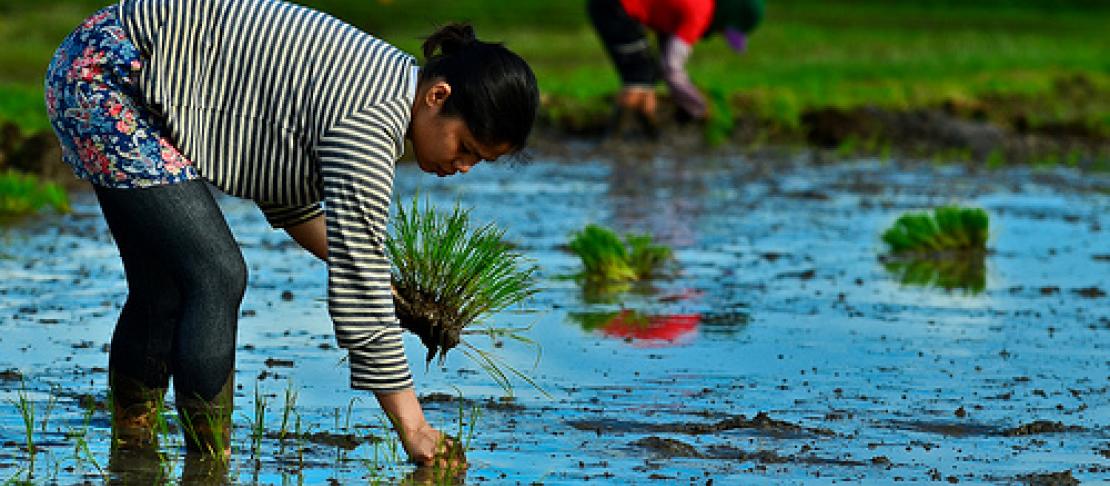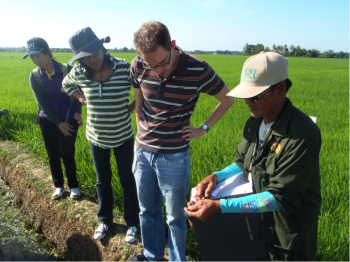Strategies for low-emission cultivation are being explored step-by-step

by Meryl Richards
Even though rice farmers in Bulacan province in the Philippines are quite concerned about the changing climate, they are even more concerned about water.
Surplus in the irrigation reservoir that provides water for the area has been steadily decreasing over the past 30 years, due to droughts and increasing water demand from the nearby capital of Manila. Since Filipino law prioritizes domestic use over agricultural irrigation use, when allocating water, this sometimes leaves farmers without enough water to irrigate their rice paddies during the dry season.
CCAFS researchers at the International Rice Research Institute (IRRI), have been working together with the Philippine Rice Research Institute (PhilRice), the National Irrigation Administration, and local irrigator’s associations to test a solution that reduces, not only water demand, but also greenhouse gas emissions (GHG) in rice paddies. This can be done through so called alternate wetting and drying (AWD).
Alternate wetting and drying is an agricultural practice whereby farmers allow their rice paddies to dry until the water table is below the soil surface before irrigating again. Compared with maintaining paddies in a continuously flooded state, this practice can lower water use by 25 per cent, and reduce energy use for pumping the irrigation water.
AWD also reduces methane emissions from rice production by 50 per cent or more because periodically aerobic soil conditions inhibit methane-producing soil bacteria.
PhilRice and the National Irrigation Administration are assessing the possibility of implementing AWD as a Clean Development Mechanism (CDM) project in a part of their  irrigation system service area, that in total includes more than 20.000 farmers in Bulacan province. One element of the assessment process is accurate measurements of the emissions reduction benefits associated with AWD—a difficult task because methods for measurements in smallholder systems are not well defined.
irrigation system service area, that in total includes more than 20.000 farmers in Bulacan province. One element of the assessment process is accurate measurements of the emissions reduction benefits associated with AWD—a difficult task because methods for measurements in smallholder systems are not well defined.
This is where CCAFS comes in.
CCAFS researchers are using the irrigated area of Bulacan province as one of several sites to test methods for measuring emissions and comparing mitigation options in smallholder agriculture, part of a project called “Standard Assessment of Mitigation Potential and Livelihoods in Smallholder Systems” (SAMPLES).
The SAMPLES project, which began in 2012, advances climate change mitigation in smallholder agriculture through several interconnected components:
(1) development of a protocol for measuring emissions and comparing mitigation options,
(2) field testing of measurement methodologies and mitigation technologies,
(3) modeling of optimal mitigation options, and
(4) capacity building for collecting and analyzing data.
The protocol will serve as a tool for scientists and decision-makers who want to analyze low-emissions agriculture strategies in smallholder systems. A group of experts from CGIAR, the Global Research Alliance on Agricultural Greenhouse Gases, academia, and national agricultural research institutions are guiding its development. The protocol will build on existing protocols for GHG measurements, but will be innovative in its focus on:
- Low-cost methods,
- Whole-farm and landscape level accounting,
- Systems analysis of farms and landscapes to guide prioritization, sampling and scaling up to levels relevant to decision makers, and
- Collection of household economic data to identify mitigation options that are economic at the household level .
Scientists associated with SAMPLES are testing methods and collecting data not only in the Philippines, but in Kenya and Vietnam as well. The field sites cover a range of smallholder systems, including intensive rice, rice-wheat rotations, and mixed systems of maize, sugarcane, livestock, and vegetables. Field research will inform the protocol and provide a full year of data and trade-off analyses for a variety of low-emissions agriculture strategies from five sites.
The five research sites are also serving as a learning laboratory for over 20 research fellows, thus building in-country capacity for implementing the strategies being tested during the project. Finally, two sets of 10 Ph.D. students have so far received funding for research on emissions measurement and reduction in smallholder agriculture through the Climate Food and Farming Network.
When SAMPLES is completed in 2014, scientists and farmers associations in the Philippines and elsewhere will have better methods and tools on which to base their decisions. Hopefully, that will mean more climate smart—and water efficient—agriculture.
CCAFS is expanding its research into Southeast Asia. Read related stories on agriculture and climate change from this part of the world on our blog.
This story was written by Meryl Richards, Science Officer for CCAFS Low Emissions Development research. To learn more about the SAMPLES project, visit the website.


